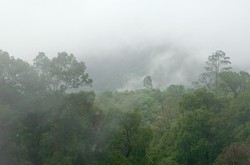The Asian summer monsoon has been weakened by historical changes in land use and vegetation cover

Trees enhance the monsoon rainfall by reducing surface wind speeds and enhancing convection. The large-scale removal of trees for farmland during the preindustrial period caused significant weakening of the monsoon. c iStockphoto/marcomanzini
The preindustrial period from the 1700s to the 1850s witnessed rapid population growth and loss of forest to croplands across Asia. These changes in land use and vegetation cover weakened the summer monsoon and reduced rainfall, according to computer simulations performed by Tetsuzo Yasunari of the Nagoya University GCOE for Basic and Clinical Environmental Studies and colleagues from the Japan Agency for Marine-Earth Science and Technology.
The Asian summer monsoon is driven by the temperature differences between land and sea, and affects about half of the world's human population. There is evidence from Himalayan ice cores that rainfall decreased by around 20% (200 mm) between 1700 and 1850.
"Global warming cannot explain this historical disturbance in regional climate because emissions of greenhouse gases and pollutants such as aerosols into the atmosphere due to human activities were still minor," says Yasunari. Similarly, the changes cannot be attributed to natural climate variations such as those caused by fluctuations in solar activity or volcanic eruptions.
However, the introduction of new crops led to a massive expansion of agriculture in Monsoon Asia during the 18th and 19th centuries. Large areas of forest were chopped down to make way for croplands. In India, this coincided with colonial management of the Mughal Empire by the British East India Company. Favorable economic policies under the Qing dynasty also led to rapid population rise and increased habitation in China.
Such dramatic changes in land use and vegetation cover affect the amount of solar heat taken up by the Earth's surface, and intensify wind speeds at low levels.
"We suspected that these changes in land use and vegetation cover were responsible for the change in climate between 1700 and 1850," says Yasunari. "To test this theory, we performed computer simulations using a global historical vegetation map reconstructed for the last 300 years."
The simulations confirmed that changes in land use and vegetation cover would have weakened the Asian summer monsoon circulation and reduced rainfall over India and south-eastern China. The findings are consistent with evidence from the Himalayan ice cores indicating lower regional rainfall in the preindustrial period.
"What our simulations show is that changes in land use and vegetation cover can have a profound influence on regional climate," says Yasunari. "Any attempts to understand contemporary climate change or to predict future Asian monsoon climate must consider these factors in addition to increases in greenhouse gases and aerosols."
Affiliated Researchers
The Nagoya University affiliated researchers mentioned in this highlight are from the GCOE for Basic and Clinical Environmental Studies (BCES)
Reference
- Takata, K., Saito, K. & Yasunari, T. Changes in the Asian monsoon climate during 1700-1850 induced by preindustrial cultivation. PNAS 106, 9586-9589 (2009). | article